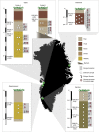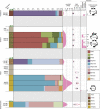DNA evidence of bowhead whale exploitation by Greenlandic Paleo-Inuit 4,000 years ago
- PMID: 27824339
- PMCID: PMC5105157
- DOI: 10.1038/ncomms13389
DNA evidence of bowhead whale exploitation by Greenlandic Paleo-Inuit 4,000 years ago
Abstract
The demographic history of Greenland is characterized by recurrent migrations and extinctions since the first humans arrived 4,500 years ago. Our current understanding of these extinct cultures relies primarily on preserved fossils found in their archaeological deposits, which hold valuable information on past subsistence practices. However, some exploited taxa, though economically important, comprise only a small fraction of these sub-fossil assemblages. Here we reconstruct a comprehensive record of past subsistence economies in Greenland by sequencing ancient DNA from four well-described midden deposits. Our results confirm that the species found in the fossil record, like harp seal and ringed seal, were a vital part of Inuit subsistence, but also add a new dimension with evidence that caribou, walrus and whale species played a more prominent role for the survival of Paleo-Inuit cultures than previously reported. Most notably, we report evidence of bowhead whale exploitation by the Saqqaq culture 4,000 years ago.
Figures



References
-
- Raghavan M. et al.. The genetic prehistory of the New World Arctic. Science 345, 1255832 (2014). - PubMed
-
- Arneborg J. et al.. Norse Greenland Dietary Economy ca. AD 980–ca. AD 1450: introduction. J. North Atl. S3, 1–39 (2012).
-
- Grønnow B. et al.. At the edge: High Arctic Walrus hunters during the Little Ice Age. Antiquity 85, 960–977 (2011).
-
- Gulløv H. C. Grønlands Forhistorie. 1–434 (Gyldendal, 2004).
-
- Meldgaard M. Ancient Harp Seal Hunters of Disko Bay. Meddelelser om Grønland: Man & Society, (2004).
Publication types
MeSH terms
Substances
LinkOut - more resources
Full Text Sources
Other Literature Sources
Miscellaneous

